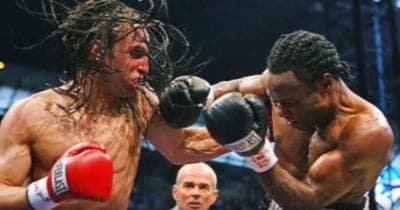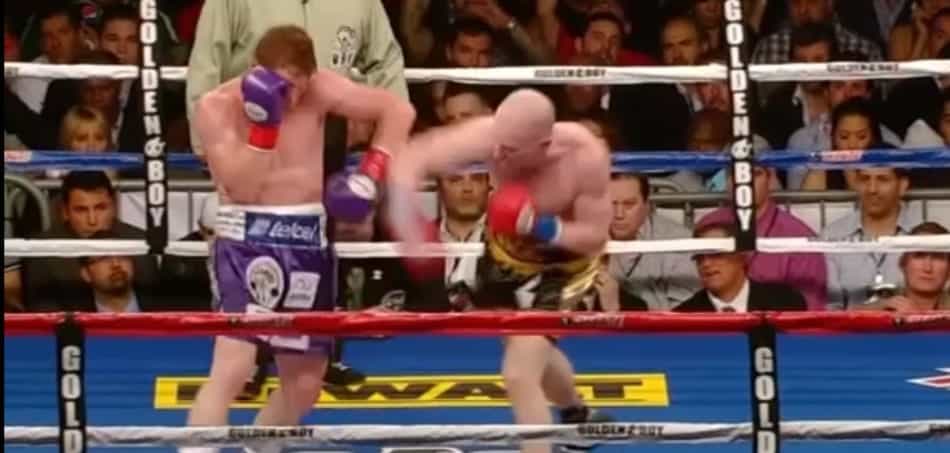
Can you block with an elbow in boxing? With the rise of bare-knuckle fighting now forcing punchers to think outside the glove for defense, this question is hotter than ever.
In short, yes, it is perfectly legal to block punches with your elbows.
Boxing rules neither endorse nor prohibit the use of elbows for blocking, which means they’re fair game in both amateur and professional contests. Film study shows that elbow blocks have been a staple technique for top-level boxers for decades (and not just the classic “anti-body shot” elbow block, either):
These advanced elbow blocks and parries set up the offense, inflict damage, enhance your defense, and more, as long as you’re doing them right! When done incorrectly, elbow blocks do more harm than good: they foul, they cut, and they leave you wide-open.
Today’s post is all about optimizing your elbow blocks. Read on to learn exactly why this “controversial” block is 100% legal, discover all the advantages of elbow blocking versus traditional defense, and level-up your defensive game with some simple technical tips.
To learn all the other ways of defending punches, check out this article: 22 Tips on How to Take a Punch in Boxing Like a Pro
What the boxing rules say about using your elbow?
Official boxing rules state that you “cannot hit with your head, shoulder, forearm, or elbow,” but otherwise fail to mention elbows in any other capacity.
Understandably, this creates a bit of a grey area; since the rules neither endorse nor prohibit the use of elbows, beginners get left wondering.
So what’s the verdict? Can you block with your elbow in boxing? Yes!
Since elbow blocks aren’t illegal, they’re fair game. Just like you’re trained to fight until the ref says stop, you should use every technique in your arsenal unless the rules explicitly say otherwise.
And should you choose to block with the elbow, know that you wouldn’t be the first! In fact, it’s a bread-and-butter technique for dozens of top-tier professionals and all-time greats, including:
- Saul “Canelo” Alvarez
- Floyd Mayweather
- Winky Wright
- Jose Luis Castillo
- George Foreman
- Larry Holmes
- Andre Ward
But knowing that you can block with the elbow isn’t enough. Before you try it out in sparring, it’s critical that you understand the why, the how, and the when behind this technique–and even more important that you drill proper elbow blocks diligently. Read the rest of this article to learn the do’s and don’ts, then get your reps in with shadowboxing and partner work before you try it live.
Elbow block advantages
You know you can block with your block in boxing. But why would you want to? After all, isn’t that what gloves are for?
As you’ll learn, elbow blocks and parries offer a number of unique advantages:
- Hitting elbows hurts. Using the elbows to block is a great way to discourage and even potentially injure power punchers. Plenty of pro boxers have broken their hands hitting elbows. My heart weeps for anyone fighting in 4 ounces or less.
Unlike a big, padded boxing glove, the olecranon–from the Greek olene (elbow) and kranon (head)–is a large, thick, and curved bone that is no fun to punch, even with 16-ounce gloves. When fist and olecranon collide at high speed, my money’s always on the elbow.
- Elbows provide more coverage for blocks and parries. If someone was throwing rocks at your head, would you defend yourself with a buckler or a riot shield? Easy choice–when it comes to blocking and parrying incoming fire, more coverage is always better.
“Shield size” is one reason elbow blocks are so valuable. Granted, the olecranon itself is smaller than a boxing glove, but elbow blocks naturally involve the forearm, unless we’re specifically talking about elbow “flips” (more on that later).
So to rephrase the opening question in a boxing context: would you rather block a punch with your hand or the entire lower half of your arm?
The same idea applies to elbow parries. With traditional parries, the “parrying tool” (i.e. the hand) is only as big as your glove. With so little coverage, it takes a considerable amount of skill and accuracy to catch and redirect incoming punches.
Parrying with the forearm and elbow is much easier. Instead of a palm’s worth of coverage, you get the entire bottom half of your arm to use as a shield. Rather than trying to pinpoint parries, simply sweep your arm through the opponent’s punch lanes to pick off the incoming fire. This style of parrying is advanced, and it works best from a “long guard” position, as demonstrated by below Gabriel Rosado and Andre Ward.

- Elbow blocks leave the hands free to defend. When defending body punches, you’re taught to never reach down with your glove, as this exposes your head. Crafty opponents will feint your hands out of position and punish you for making this mistake.
By blocking body shots with the elbow, you keep the glove in a defensive position. The hand never has to move from the face–just bend the knees and “side crunch” your elbow/forearm into the shot with your defense in tact.
Winky Wright was a master of this. Notice how he picks Trinidad’s hook off without ever moving his right glove off his face. This allows him to nullify Trinidad’s crafty same-side combination (left hook to the body, left hook to the head):
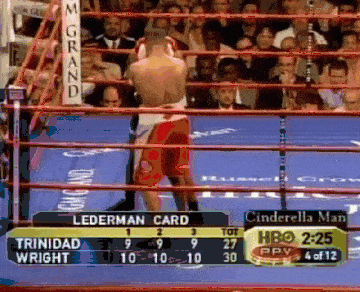
- Elbow blocks aren’t boxing-specific. The standard boxing guard is sometimes criticized from an MMA and self-defense perspective because it relies on big, padded gloves. As a quick aside, let me say that many of these criticisms are flawed in that they assume the boxing guard is a static “shell,” when in reality it is much more dynamic. But I digress.
Boxing guard critics are right about one thing: you can’t bring a boxing glove into MMA or self-defense scenarios. But you can bring your elbows! And whether you’re in an Octagon, a back alley brawl, or a 100-man kumite, nothing changes: the elbow blocks you work in the boxing gym will serve you just as well.
- Elbow blocks can stop counter punches. In boxing, sometimes your hands get caught out of position, but they’re not your only defensive tools. Learning how to block with the elbows–especially immediately after throwing a punch with that same hand, as shown below–creates a second line of defense to keep you safe against even the best of counter punchers. Even if the opponent beats your hand, they have to get past the elbow, as Jose Luis Castillo demonstrates off the cross:
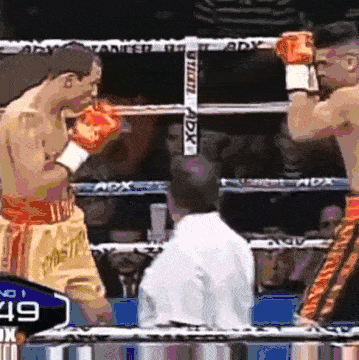
Here we see Canelo using the same elbow block technique off a left hook, denying Matthew Hatton’s counter right:
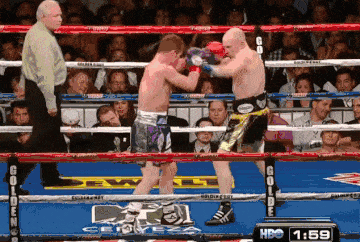
- Elbow blocks create counter-punching opportunities. As mentioned previously, blocking with the elbow keeps the hand free to defend. But that free hand can just as easily punch!
Indeed, elbow blocks create excellent same-side counter-punching opportunities, particularly against body punches. Since they involve placing the elbow between your body or head and the opponent’s glove, elbow blocks naturally get your arm on the “inside track” (i.e. inside the punching arc), which means you can cut straight down the middle and beat the opponent’s hand home.
With these same-side counters, try to think of your elbow like a “button”–when the opponent “pushes the button” (i.e. their punch lands), you immediately launch your counter shot.
Elbow parries also create beautiful opposite-hand counter-punching opportunities in the same way that a standard block or shoulder roll does. Check out Floyd Mayweather’s nasty elbow parry counter against Victor Ortiz for a beautiful example:
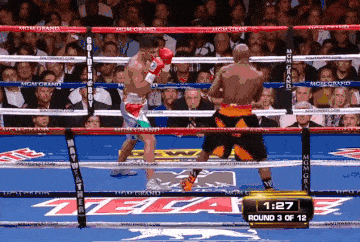
With this parry, Mayweather uses the elbow/forearm like a bar and lifts Ortiz’s jab away, then slams home a perfect right cross counter.
Tips for legal and effective elbow blocks
Wrapping up, here are a few rapid-fire tips to make your elbow blocks better and avoid fouling:
- Keep the elbows close to the body. “Elbows in” is a universal martial arts concept that appears in boxing, jiu-jitsu, muay thai, and many other forms of combat and self-defense. Rightly so–when you hold the elbows close to the body, you’re strong and well-protected; conversely, when your elbows are out, you’re weak and wide-open.
With that in mind, it’s crucial that you keep your elbows close to the body, even when you’re experimenting with long guard options that require the hands to be extended. Look closely at Ward and Mayweather in the above clips: even when their arms drift off their bodies, they’re kept close to the torso, always ready to block or punch at a moment’s notice.
- Never point the spike of the elbow directly at the opponent. Though you can “spike” the elbow down onto body punches and parry with it directly, you should never point the spike of the elbow at your opponent like a spear. In this position, the point of the elbow becomes a blatant fouling tool that can cut or strike your opponent, which is against boxing rules. This motion also folds your arm back into your chest, which effectively disables that hand for punching.
- Create proactive “defensive traffic” with the elbows. Most beginners are taught to block and parry “reactively,” which means they move their hand to defend in response to the opponent’s punch. This works fine, but it’s not the only way to defend.
As you continue to drill your elbow blocks and experiment, consider adding proactive blocks and parries to your game using “defensive traffic.”
“Proactive” defense refers to using the blocking or parrying motion with the elbow before the opponent punches. The goal here is to place “defensive traffic” (i.e. your elbow/forearm) in the path of the punch before it is thrown.
Blocking and parrying before any punches are thrown may sound silly–you literally “block” or “parry” the empty air between you–but taking the initiative in this way denies the opponent that opening before they can attack.
More often than not, they’ll attack somewhere else instead of punching into traffic. In this way, proactive blocks and parries give you a degree of control over your opponent’s offense, thereby decreasing the number of threats you have to be aware of at that moment and freeing up your faculties for reactive defense.
This is what we see Andre Ward doing by “floating” horizontal forearm in the space between him and his opponent, and what Mayweather is doing by flipping the elbow up even when Ortiz isn’t punching.
Now get to work! Those elbow blocks won’t drill themselves.


